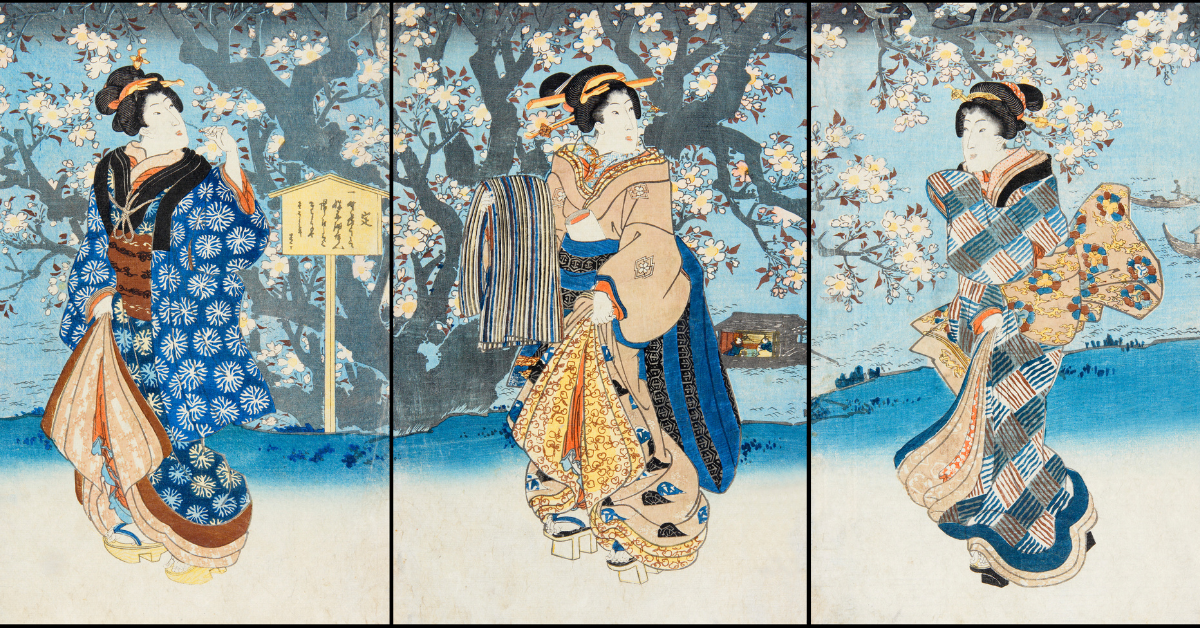Ukiyo-e, born in the Edo period, is a form of printmaking that also served as a record of everyday life and entertainment. Accessible to common people, ukiyo-e eventually spread across the world and became a driving force that reshaped the course of global art.
What is Ukiyo-e?
Ukiyo-e refers to a print art enjoyed by commoners in the Edo period of Japan. Because it was created using woodblock printing, it could be produced in large numbers, making it widely accessible to the public. The word “ukiyo” means “the fleeting nature of this world” or “enjoying the present moment,” and ukiyo-e captured people’s interests and aspirations of the time.
Early works were monochrome prints in black ink, but with the invention of multi-colored printing (nishiki-e), artists achieved a wider range of expression. This innovation allowed vibrant depictions of clothing and landscapes, transforming ukiyo-e into a unique form of printed art unparalleled in the world.
Main Themes of Ukiyo-e
The subjects of ukiyo-e were extremely diverse, reflecting the lifestyles and trends of the Edo period.
| Theme | Content | Example |
|---|---|---|
| Bijin-ga (Pictures of Beauties) | Depictions of fashion and women of the time | Kitagawa Utamaro |
| Yakusha-e (Actor Prints) | Portraits of kabuki actors | Tōshūsai Sharaku |
| Fūkei-ga (Landscape Prints) | Famous places and natural scenery | Katsushika Hokusai’s Thirty-Six Views of Mount Fuji |
| Giga & Satirical Prints | Humorous or critical portrayals of society | Utagawa Kuniyoshi |
Ukiyo-e was not only an art form but also a medium of entertainment and information for common people, covering theater, travel, and even fashion.
Techniques and Production Process
The creation of ukiyo-e was a collaborative process involving the painter, carver, and printer. This division of labor made mass production possible, spreading ukiyo-e widely.
| Role | Contribution |
|---|---|
| Painter | Designed the original drawing and artistic vision |
| Carver | Carved the design into woodblocks |
| Printer | Applied pigments and printed onto washi paper |
This teamwork resulted in works that combined artistry with technical precision, elevating ukiyo-e into a world-class form of printmaking.
The Role of Ukiyo-e in Japan
In Edo-period Japan, ukiyo-e was art accessible to everyone, unlike expensive oil paintings. Since it could be mass-produced, it functioned much like magazines or posters today.
- Bijin-ga acted like fashion magazines, showing the latest hairstyles and clothes.
- Actor prints worked as kabuki theater advertisements.
- Landscapes inspired travel aspirations during the Edo travel boom.
In this way, ukiyo-e was not only art but also a form of mass media that supported daily life.
Ukiyo-e and Edo’s Urban Culture
Edo was a bustling city with over one million residents, and ukiyo-e was deeply tied to its entertainment, tourism, and commerce.
| Field | Role of Ukiyo-e |
|---|---|
| Entertainment | Popular portraits of kabuki actors and sumo wrestlers |
| Tourism | Landscape prints served as travel guides |
| Fashion | Beauties introduced new clothing trends |
| Commerce | Used in advertisements and packaging |
Thus, ukiyo-e served not only as fine art but also as a cultural medium woven into urban life.
Global Influence of Ukiyo-e
When Japan opened to the world in the mid-19th century, ukiyo-e prints flooded into Europe, sparking a cultural phenomenon known as Japonisme.
Impressionist painters like Monet, Degas, and Van Gogh were captivated by ukiyo-e’s nonlinear composition, bold use of color, and innovative perspectives. Van Gogh even copied ukiyo-e prints and incorporated their styles into his own works.
The decorative, flat aesthetics of ukiyo-e also influenced Art Nouveau and modern design, making ukiyo-e a crucial force in shaping Western art.
Famous Ukiyo-e Artists and Their Works
Ukiyo-e produced numerous masters whose works remain celebrated worldwide.
| Artist | Masterpiece | Distinctive Feature |
|---|---|---|
| Katsushika Hokusai | Thirty-Six Views of Mount Fuji | Dynamic compositions and natural depictions |
| Utagawa Hiroshige | The Fifty-Three Stations of the Tōkaidō | Poetic and lyrical landscapes |
| Kitagawa Utamaro | Woman Blowing a Glass Toy | Pioneer of bijin-ga |
| Tōshūsai Sharaku | Portrait of Ōtani Oniji III | Bold and expressive actor portraits |
These artists’ works are now regarded as artistic treasures exhibited in museums around the world.
The Modern Role of Ukiyo-e
Today, ukiyo-e continues to serve as a cultural icon representing Japan. It is preserved in museums and galleries, but its influence also extends into tourism, education, and even contemporary design.
Modern designers frequently incorporate ukiyo-e motifs into posters, fashion, and digital art, blending tradition with innovation. For foreign visitors, ukiyo-e serves as an entry point to understanding Japanese history and aesthetics.
Conclusion
Ukiyo-e emerged from the everyday culture of Edo Japan as woodblock prints that were both art and mass media. They functioned as entertainment, fashion guides, and travel advertisements, while also leaving a lasting impact on global art movements such as Impressionism and Art Nouveau.
Even today, ukiyo-e is more than a historical artifact. It is a cultural bridge linking the past and present, continuing to inspire artists and audiences worldwide. Ukiyo-e remains a symbol of Japanese aesthetics and will keep creating new value for generations to come.






